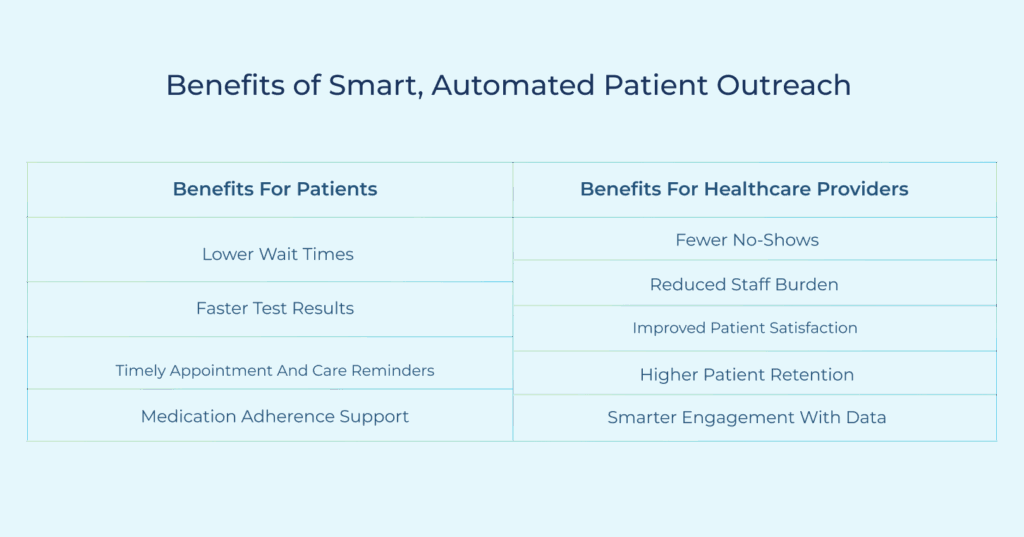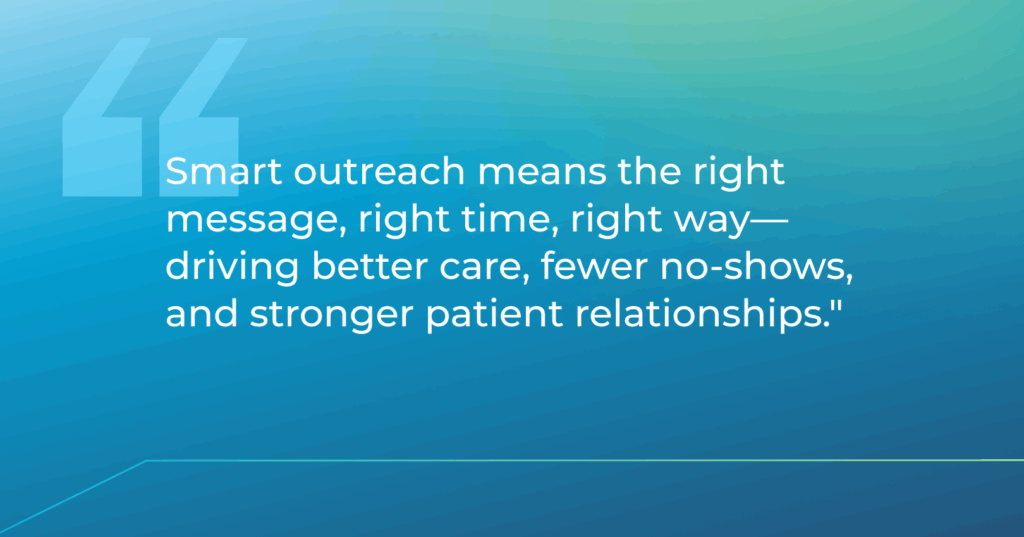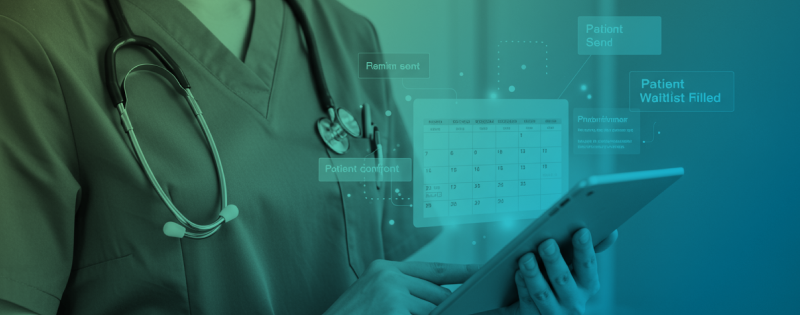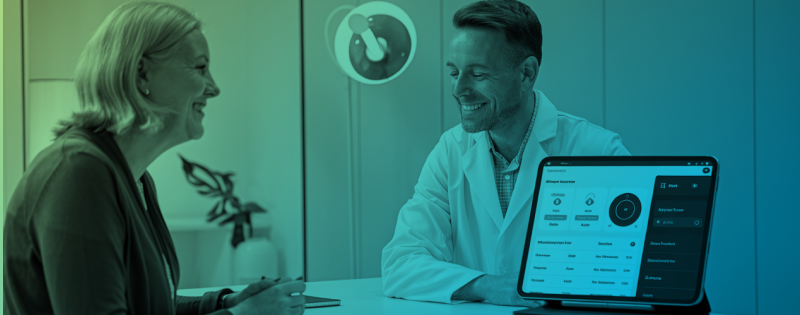When patients miss their vaccinations, it leaves both them and their communities exposed to preventable…

Smart Patient Outreach Strategies for Better Outcomes & Fewer No‑Shows
The old ways of spamming messages in bulk to the same patient are long gone. Today, it’s all about sending the right message at the right time. It means healthcare providers need to know who they are talking to, what the patient needs, and how they prefer to hear from their providers.
While patient outreach is not a new concept, most providers fail to improve their response rates because they still treat it as a mass message delivery system. The following blog will touch on that further, explaining why a smart, targeted outreach program can help both patients and providers alike.
What’s Patient Outreach?
Think of patient outreach as a smarter, more connected way to keep patients informed at every step. Providers no longer limit their patient engagement to just scheduled appointments. They instead take the initiative by reaching out first with timely updates like test results, preventive medication reminders, and critical follow-ups after procedures.
Hence, patients can stop chasing for answers or waiting for the next appointment, because their provider is already reaching out.
However, success and response rates depend on the messaging and how it was sent. The patients’ preferred communication channels are important in this regard.
Some prefer phone calls, while others prefer text messages. In-app or patient portal alerts are also highly useful. Adapting the reach for each patient is how healthcare providers leverage a multi-channel approach for better patient engagement.
Strategies for Effective Patient Outreach for Healthcare Providers
Regular communication leads to better health outcomes as well as measurable benefits for providers. This is what patient outreach is all about. Here are some highly effective strategies to improve your patient outreach.
Personalize Outreach Through Dynamic Patient Segmentation
Your outreach is more successful if you know who you’re talking to. So, stop broadcasting the same message to everyone. You’re never going to increase your response rate doing it that way.
Rather, split your patients into segments based on dynamic indicators such as health status or risk. Rather, split your patients into segments based on dynamic indicators such as health status or risk. It will make every message feel more personalized and relevant.
Automate Appointment Reminders and Follow-Ups
Create smart, multi-channel reminders (text, phone, email) and time them close to the appointment. Add a follow-up if they miss it. Patients are more likely to show up when they know you’re expecting them. This also saves staff from making reminder calls manually. It makes all the difference when it comes to reducing no-show rates.
Leverage Multi-Channel Communication Based on Patient Preferences
Offer options. Some prefer texts. Others want email or voice. Let patients choose. Response rates improve when people hear from you the way they prefer. Set and update these preferences in their records.
Utilize Two-Way Communication for Better Engagement
Two-way messaging lets patients actually respond to your appointment reminders. Instead of just getting a text that says “You have an appointment tomorrow,” they can reply “Yes,” “Need to reschedule,” or “Cancel” right in the message thread.
The AI handles these responses automatically and updates your schedule without anyone at the front desk lifting a finger.
This fixes the biggest problem with one-way reminder systems. Patients get a text, but still have to call the office to change anything. Half the time, they’d just skip the appointment instead of dealing with phone tag. Now they text back and get options immediately.
Your patients expect this kind of instant response and convenience in 2025, which is why healthcare systems are shifting toward self-service portals. It gives patients more control over their care while reducing workload for your front desk.
Streamline Pre-Visit Prep and Post-Visit Follow-Up Communication
Send prep instructions before appointments. Follow up afterwards with summaries or next steps. It’s important to stick to clear, useful details, no filler. Patients will remember what to do, and your team will avoid repeat calls. It’s a win-win.
Incorporate AI-Driven Outreach for Smarter Engagement
Use data from past visits to time messages better. Track when patients are most likely to respond and use that to send tailored messages at the right time. Make sure that you are also adjusting your content based on the patients’ history, age, or condition. Be short and relevant. The best patient outreach strategy is to only send what matters to them, and that too, using the channel they respond to the most.
Include Educational Content in Patient Outreach
If a patient is due for a test, tell them why in plain terms. If they start a new treatment, explain what to expect. Send articles or tips that are easy to read. Keep links short and focused. Avoid technical language unless necessary.
Map the Outreach Across the Entire Patient Journey (Touchpoints)
Outreach starts before care even begins. Welcome messages help set the tone when patients schedule their first appointment. It helps ease uncertainty and build early by explaining what the patient’s next steps, forms, or prep details etc.
Once treatment is underway, communication shifts to managing appointments, sharing test results, and coordinating next steps. Timely, relevant updates keep patients informed and engaged throughout their care.
After treatment ends, outreach keeps the connection alive. Follow-up surveys invite feedback. Wellness reminders prompt preventive care. Even simple touches like birthday messages or annual check-ins help patients feel remembered, and more likely to return when they need care again.
Mistakes to Avoid With Patient Outreach
It’s common for most healthcare organizations to struggle with their patient outreach programs. The mistakes mentioned below end up wasting your efforts while also damaging patient relationships.
- Message Fatigue: Don’t confuse patient outreach with a license to spam them with messages all day long. Stick to only the most essential content. Tracking your response rates will help you optimize this further.
- Poor Data Quality: Have your front-desk personnel check contact information with each patient visit. This way, your outreach isn’t wasted on a phone number that was cut off months ago.
- Compliance Issues: Healthcare communications are subject to HIPAA requirements and patient consent regulations. Get patient consent in writing before sending automated messages, and have your staff trained on privacy regulations.
- Incorrect Channels of Communication: Presuming everyone would like to have text messages or calls is off the mark. Some patients are interested in receiving emails, while others require paper letters. Get patients’ preferred communication channels at the time of registration.
- Poor Timing: Appointing reminders that go out too early or too late will hurt your outreach. Experiment with varying time intervals to determine what is best for your patient base. Most patients do respond positively to reminders 24-48 hours before appointments.
Benefits of Smart, Automated Patient Outreach

Automated patient outreach tools enable healthcare organizations to maintain a high level of communication while reducing manual effort. The tools leverage patient information to deliver timely, relevant communications via desired channels.
While automated appointment reminders are considered a staple requirement, smart outreach goes much further, adapting to patient behavior over time to deliver several other types of content.
Benefits for Patients
Patients are better and more effectively coordinated and connected to their care team by automated outreach.
- Lower Wait Times: Patients are notified in advance what documents or paperwork they need to bring. They are also alerted if their appointments have been delayed.
- Faster Test Results: Patients automatically receive their lab results as soon as they are made available. They can quickly plan their next steps, which beats waiting for phone calls or rushing to the lab for a printed copy.
- Timely Appointment and Care Reminders: Patients receive automated notifications for upcoming appointments, annual screenings, and vaccination schedules. This prevents missed preventive care and helps patients stay on track with their health management.
- Medication Adherence Support: Automated reminders help patients take medications on schedule and refill prescriptions before running out. Patients with chronic conditions like diabetes or hypertension see better health outcomes when they maintain consistent medication routines.
Benefits for Healthcare Providers
Smarter outreach gives providers a strategic advantage that drives better outcomes and engagement. It completely reshapes how you connect with your patients.
- Fewer No-Shows: Automated reminders significantly cut down the chance of missed appointments, keeping your daily schedules full and revenue flowing.
- Reduced Staff Burden: Say goodbye to endless phone calls. Automation handles your daily outreach, so your staff can spend their efforts on delivering care.
- Improved Patient Satisfaction: When patients receive thoughtful, proactive communication, they feel seen, supported, and valued. It deepens trust and builds long-term loyalty.
- Higher Patient Retention: Regular touchpoints keep patients engaged with your practice and less likely to drift elsewhere.
- Smarter Engagement With Data: Built-in analytics show which channels and messages work best, so you can tailor outreach based on real-time patient behavior and preferences, not just guesswork.
Get Started with TeleVox for Smarter Patient Outreach
As far as patients are concerned, modern healthcare is all about real-time, personalized engagement. There’s no room for negotiations. We at TeleVox understand perfectly how these concerns can be addressed. We equip providers like you with the right tools to effectively engage patients. Our automated solutions shift your generic messaging to a more personalized, human-centric communication across the patient’s journey.
With Smart Agent at the core, our advanced conversational AI takes care of appointment scheduling, confirmations, rescheduling, and more without losing the human touch. It makes sure that your outreach feels personal, proactive, and completely hands-off.
Let your staff focus on delivering care rather than managing calendars. See for yourself how the next generation of healthcare outreach works.




